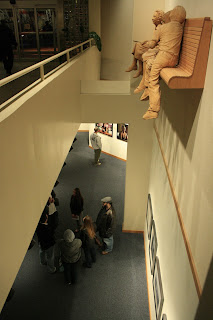Spokane Arts Commission presented four photographers at the Chase Gallery. The opening was on November 5th from 5 to 8 p.m. The Chase gallery is located in City Hall. Artists include Zachary Mazur, Greg Siple, Ian Van Coller, and Jian Yang. The exhibition will be up until December 30.
Zachary Mazur, Washington, focuses on the interactions between humans and the environment, according to the gallery statements. In this show all of his photographs were black and white.
Montana based, Greg Siple, also presented in black and white. His work is a collection of profiles and photos of bikers for Adventure Cycling Association, which he helped found, and is currently the art director for.
Ian Van Coller is the only artist in the show that used colored images. He grew up in South Africa which is influential to his work in portraiture.
Jian Yang’s work is black and white. He is from China, and focuses on spaces and objects which are abandoned or left.
 |
| Artist sits and talks with guest |
 |
| Art goers exchange a few words |
As a whole, the crowd filtered in and out as the space held a handful of viewers throughout the opening. The set up of the show was a bit disconnected. Three of the four artists had black and white photos, while one had color. It maybe could have been set up in a different fashion aesthetically. Three of the four artists framed or matted their work, and one did not. This may have been intentional, but it was not really clear due to the manner in which the pieces were hung. They were crooked in a somewhat messy way. If it was intentionally done to add to the works aesthetics, it was not effective. It did not appear as though it added to the photographs, rather it took away from the actually photographs.
How important is it to unify an entire art show, and does an un-unified art show affect the environment of the show for the viewers?
How important is it to unify an entire art show, and does an un-unified art show affect the environment of the show for the viewers?

4 comments:
As you described, it seems like in order for an art show to be effective, unity is necessary. It is not very appealing and can also be distracting when art is not presented in a nice, neat manner. The shows I have been to this year have not had any issues with set up so it was interesting reading your review. I personally think that variety is nice when viewing art, but only when used in an effective manner. The fact that some works were framed and matted while others were not, and that some things were crooked indicates that it most likely was not intentional. Un-unified art can give the message that it was rushed or carelessly set up, and it is unattractive to the viewer. I know how this goes, because I rush when it comes to presenting my work usually. haha
I think you bring up an excellent point Kellen. The unity of a show or at least the unity of one artists display is very vital to convey a strong professional piece. You mentioned that the show had a couple of pieces that were poorly mounted and cut, and I believe that this shows the importance of neat professionally, or maybe not necessarily neat, but unified presentation of elements. As the viewer, these elements that weren't unified within the exhibit stuck out to you and that is what you remembered. The artist failed to convey their content because of a lack of formal unity within their show. So in response to your question I believe that the unity of the show is very important. It can successfully convey content or it can do just the opposite, it can distract viewers from what they should be experiencing. This is a good thing to keep in mind as one presents their work, and i'm glad that you brought up this question.
I think that unity is one of the most important aspects of an art show. I get the feeling of being disconnected from the works when I am distracted by color vs. black and white, and pictures that are not level when they are hung. I feel that I start thinking of what I would change or what annoys me more then the works in general, and unfortunately it greatly takes away from the artists intent and the beauty of the works themselves.
I completely agree with you Jake and Chessa. A viewer's memory of a show shouldn't be the flaws about the pieces, but about the pieces themselves; and the unity of a show has a lot to do with this as Jake said. Our eyes are naturally drawn to things that stick out, good or bad, and this could tamper with our interpretation and appreciation for the work.
Post a Comment